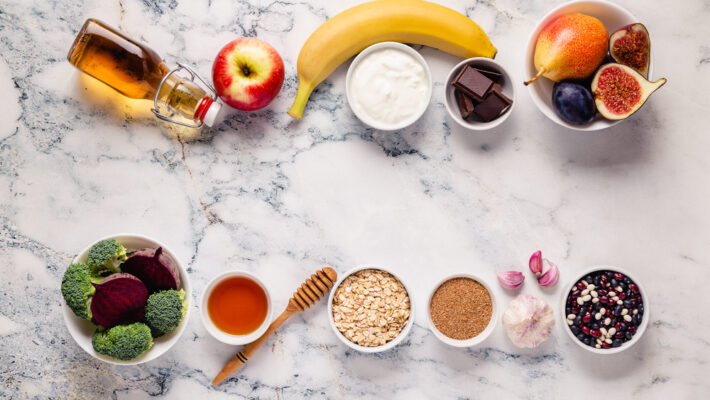
A Healthy Gut Needs a Microbiome-Friendly Diet
Your gut plays host to a complex community of trillions of bacteria known as your gut flora, or gut microbiome. The gut microbiome is comprised of a delicate balance of “good” and “bad” bacteria that play a role in digestion and absorption of nutrients as well as general support for your immune health. However, due to environmental factors and a unhealthy diet, your microbiome may suffer a state of imbalance known as dysbiosis, which can ultimately result in digestive or general health concerns. The best way to support your gut flora is to eat a microbiome-friendly diet. This diet is designed to feed your gut bacteria to replenish and support a healthy microbiome. Let’s take a closer look at the microbiome diet and how you can benefit from it.
What is the Microbiome-Friendly Diet?
Unlike other diets, the microbiome-friendly diet does not aim to restrict calories or food groups. The diet as a whole revolves around the idea that your gut microbiome is the key to optimal health and body function. By feeding the good bacteria, you can maintain a balance that can promote good digestion, support your immune system, stabilize your mood, and even help you maintain a healthy weight. The microbiome diet primarily does that by incorporating more prebiotics, fiber, probiotics, and other nutrient-rich foods into your meals. Daily bovine colostrum supplementation with its full complement of growth factors is also key to promoting good health.
The Phases of the Microbiome-Friendly Diet
The microbiome diet generally follows three phases of progress.
Phase 1
The first phase, which lasts three weeks, maintains the crux of the diet and aims to:
- Repair the gut lining
- Subtract elements and foods that disrupt a healthy microbiome balance
- Replace digestive enzymes and stomach acids
- Replenish your gut bacteria with probiotics
The main foods to remove are refined carbohydrates, processed foods, fats, sugars, artificial colorings, and fillers (junk food), all of which may disrupt beneficial bacteria and make room for “bad” bacteria to grow. Removing these foods from your diet gives your gut a “rest” by halting the assault. The microbiome begins recomposing itself almost immediately, but bovine colostrum’s growth factors are absolutely necessary to assist in the repair of the gut lining. Specific foods to avoid include:
- Gluten
- Soy
- High-fructose corn syrup
- Corn
- Potatoes
- Fried foods
- Fish with a high mercury content
- Eggs
- Grains
- Peanuts and legumes
- All dairy except for butter
These foods can be replaced by organic, plant-based foods that are high in fiber. While you can still generally enjoy grass-fed or pasture-raised meats on this diet, plant-based, prebiotics, which are high-fiber foods are essential to feeding your gut. Fiber is technically a carbohydrate, but it is not easily digestible. This means that it can reach your intestines (where most of your microbiome lives) relatively intact. The gut bacteria feed on the fiber, thriving and growing while releasing short chain fatty acids. Prebiotic foods include:
- Garlic
- Asparagus
- Onions
- Leeks
- Radishes
In addition to prebiotics, you’ll want to supply yourself with a healthy helping of probiotic-rich foods and supplements. This mainly consists of fermented foods, including yogurt, kimchi, kefir, and kombucha. These increase the number of bacteria and general diversity in your gut.
From there, you can maintain the same eating habits as long as you’re making smart choices. Eating a wide range of fresh fruits (which are generally high in fiber themselves) is encouraged, and you can get healthy fats from wild-caught fish, nuts, and seeds. With animal proteins, you can choose from the gamut, but it’s always better to go with organic, free range, and cruelty-free.
Phase 2
Once the three weeks are up, your intestines should have significantly healed. During phase 2, which lasts the next four weeks, you can gradually incorporate foods that were removed in the first phase, including:
- Eggs
- More fruits
- Sweet potatoes and yams
- Goat’s and sheep’s milk and milk products
- Gluten-free grains (millet, buckwheat, oats)
- Legumes (all types of beans)
Phase 3
After week four of phase 2, your intestines are healing or fully healed and your microbiome has returned to a balanced, healthy state. You can and should continue to maintain the microbiome diet, but by now, it’s more about listening to your body and taking colostrum daily. Colostrum supplementation will help maintain integrity of the gut lining, but you need to take care in avoiding gut-irritating glyphosate-contaminated foods, GMOs, high sugar foods, processed foods, fast foods, and alcohol.
Benefits of the Microbiome Diet
When it is thriving, the microbiome produces these compounds, which contribute to your overall health by:
- Fueling your intestinal cells
- Promoting growth of good bacteria
- Improving immune balance
- Promoting brain function
- Balancing mood, including easing depression and anxiety symptoms
Research is still being done to get a better understanding of the gut microbiome and its link to nearly every other system in the body. The goal is to learn how to care for and improve the gut microbiome.
This article was brought to you by Sovereign Laboratories, a world leader in the development of liposomal delivery to maximize the bioavailability of our dietary supplements.


